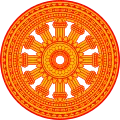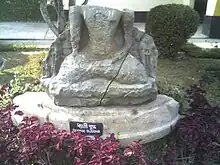| Part of a series on |
| Theravāda Buddhism |
|---|
 |


Buddhism is the third-largest religious affiliation and formed about 0.63% of the population of Bangladesh.[1][2] It is said that Buddha once in his life came to this region of East Bengal to spread his teachings and he was successful in converting the local people to Buddhism, specially in the Chittagong division and later on Pala empire propagate and patronized Buddhist religion throughout the Bengal territory.[3] About 1 million people in Bangladesh adhere to the Theravada school of Buddhism.[4] Over 65% of the Buddhist population is concentrated in the Chittagong Hill Tracts region, where it is the predominant faith of the Rakhine, Chakma, Marma, Tanchangya, other Jumma people and the Barua. The remaining 35% are Bengali Buddhists. Buddhist communities are present in the urban centers of Bangladesh, particularly Chittagong and Dhaka.
History

Legend said that Gautama Buddha came to the region to spread Buddhism, and it was speculated that one or two individuals became monks to follow in his footsteps. However, Buddhism did not gain much support until the reign of Asoka when Buddhism gained a toehold. The Pala Empire that controlled the Indian subcontinent spread many Buddhist ideologies in modern Bangladesh and built many monasteries such as the Mahasthangarh and the Somapura Mahavihara. During the Pala Dynasty, a famous teacher named Atisha was born in the city of Bikrampur and spread Mahayana Buddhism.
Chandra Dynasty's Puranchandra and Subarnachandra adopted Buddhism, as did their successors Trailokyachandra and Srichandra who ruled Harikel and Chandradwip (Barisal).[5] The Khadga Dynasty was a Buddhist dynasty of kings that carried the surname Bhatt. They made several temples and monasteries. King Rajabhata was for example a very committed Mahayanist Buddhist.[6]
Buddhism in various forms appears to have been prevalent at the time of the Turkic conquest in 1202.[7] The invading armies found numerous monasteries, which they destroyed. With the destruction of centres of Buddhist learning, such as Nalanda University, Buddhism rapidly disintegrated.[8] In subsequent centuries and up through the 1980s nearly all the remaining Buddhists lived in the region around Chittagong, which had not been entirely conquered until the time of the British Raj (1858–1947). During the 19th century, a revival movement developed[9] that led to the development of two orders of Theravada monks, the Sangharaj Nikaya and the Mahasthabir Nikaya.
In the Chittagong Hills, Buddhist tribes formed the majority of the population, and their religion appeared to be a mixture of tribal beliefs and Buddhist doctrines. According to the 1981 census, there were approximately 538,000 Buddhists in Bangladesh, representing less than 1 percent of the population.
Demographic overview
| Year | Pop. | ±% |
|---|---|---|
| 1951 | 294,437 | — |
| 1961 | 355,634 | +20.8% |
| 1974 | 428,871 | +20.6% |
| 1981 | 522,722 | +21.9% |
| 1991 | 637,893 | +22.0% |
| 2001 | 862,063 | +35.1% |
| 2011 | 898,634 | +4.2% |
| 2022 | 1,007,468 | +12.1% |
| Source: Bangladesh government census authority[10][11] | ||
Buddhism in Bangladesh by decades[10][12]
| Year | Percent | Increase |
|---|---|---|
| 1951 | 0.7% | - |
| 1961 | 0.7% | -0% |
| 1974 | 0.6% | -0.1% |
| 1981 | 0.6% | -0% |
| 1991 | 0.6% | -0% |
| 2001 | 0.7% | +0.1% |
| 2011 | 0.6% | -0.1% |
| 2022 | 0.63% | +0.03% |
As of 2014, followers of Buddhism are mainly people of Baruas living in Chittagong city, the business city of Bangladesh and indigenous Arakanese descent living in the sub-tropical Chittagong Hill Tracts. People who follow Buddhism in Bangladesh belong to the Barua people in majority with the percentage of 65% among the 0.07% population of Bangladesh, Chakma, Chak, Marma, Tanchangya and the Khyang, who had been since time immemorial have practiced Buddhism. Other tribes, notably those who practice Animism, have come under some Buddhist influence, and this is true in the case of the Khumi and the Mru, and to a lesser extent on the other tribes.
| Division | Percentage (%) | Buddhist population ( |
Total population |
|---|---|---|---|
| Barisal | 0.18% | 14,348 | 8,173,818 |
| Chittagong | 7.08% | 1,719,759 | 24,290,384 |
| Dhaka | 0.39% | 152,274 | 39,044,716 |
| Khulna | 0.68% | 99,995 | 14,705,229 |
| Rajshahi | 0.36% | 58,877 | 16,354,723 |
| Rangpur | 0.34% | 47,080 | 13,847,150 |
| Sylhet | 0.02% | 1,621 | 8,107,766 |
| Mymensingh | 0.62% | 27,999 | 11,370,102 |
Buddhist sites

- Somapura Mahavihara in Naogaon, Rajshahi Division was built during the Pala-era and was part of a network of monasteries including Nalanda, Vikramashila and Jaggadala. It is a UNESCO World Heritage Site.
- Jagaddala Mahavihara in Naogaon, Rajshahi was an 11th century Buddhist monastic establishment located in the historical Varendra region. Was probably active till at least the 12th century.
- Halud Vihara in Naogaon, Rajshahi
- Agrapuri Vihara in Naogaon, Rajshahi
- Vasu Vihara in Bogra, Rajshahi
- Sitakot Vihara in Nawabganj, Rangpur Division.
- Bhitagarh in Panchagarh District, Rangpur Division.
- Pandit Vihara in Chittagong
- Bikrampur Vihara in Bikrampur, Dhaka Division.
- Shalban Vihara in Comilla
- Wari-Bateshwar ruins in Narsingdi, Dhaka Division.
- Nateshwar Deul, in Munshiganj, Dhaka Division
Culture

There are several active monasteries in the Chittagong, and in most Buddhist villages there is a school (kyong) where boys live and learn to read Bengali (national language) and some Pali (an ancient Buddhist scriptural language).[7] It is common for men who have finished their schooling to return at regular intervals for periods of residence in the school. The local Buddhist shrine is often an important center of village life.
Buddhism outside the monastic retreats has absorbed and adapted indigenous popular creeds and beliefs of the regions to which it has spread.[7] In most areas religious ritual focuses on the image of the Buddha, and the major festivals observed by Buddhists in Bangladesh commemorate the important events of his life. Although doctrinal Buddhism rejects the worship of gods and preserves the memory of the Buddha as an enlightened man, popular Buddhism contains a pantheon of gods and lesser deities headed by the Buddha.
The Ministry of Religious Affairs provides assistance for the maintenance of Buddhist places of worship and relics.[7] The ancient monasteries at Paharpur (in Rajshahi Region) and Mainamati (in Comilla Region), dating from the seventh to ninth century A.D., are considered unique for their size and setting and are maintained as state-protected monuments.
Persecution of Buddhists
List of massacres targeted at Hindus and Buddhists minorities by radical Islamists and Razakar:
Prominent Bangladeshi Buddhists
- Historical figures
- Atisa - 10th century Buddhist monk who played a prominent role in the spread of Buddhism to Tibet. Also an abbot at Vikramashila monastery.
- Chandragomin - 7th century Buddhist lay practitioner and poet from the Varendra region
- Traillokyachandra - 10th century King of the Chandra dynasty who converted to Vajrayana Buddhism
- Vanaratna (1384–1468 CE) who is considered the last Indian Buddhist Pandit in Tibet.
- Bhikkhus (monks)

- Karmayogi Kripasaran Mahathero
- Ven. Jyotipal Mahathero
- Rajguru Aggavamsa Mahathera
- Rajguru Priyo Ratana Mahathera
- U Pannya Jota Mahathera|Ven. U Pannya Jota Mahathera
- Ven. Prajnananda Mahathera
- Suddhananda Mahathero
- Bishuddhananda Mahathera
- Administration
- Barrister Devasish Roy, Chakma Raja (Chakma Circle Chief)
- Bijoy Giri (15th Chakma Raja of Chakma Circle)
- Benita Roy (aristocrat, litterateur, diplomat, minister and Rani of Chakma Circle)
- Raja Nalinaksha Roy (49th Raja Of Chakma Circle)
- Mong Prue Sain (King of Mong Circle)
- Freedom fighters
- UK Ching, Bir Bikram
- Dharma Darshi Barua
- Politics
- Dilip Barua (Communist Party of Bangladesh (Marxist–Leninist) (Barua)). Former Minister of Industries.
- Jyotirindra Bodhipriya Larma
- Manabendra Narayan Larma
- Charu Bikash Chakma
- Kalparanjan Chakma
- Ma Mya Ching
- Aung Shwe Prue Chowdhury
- Sacing Prue Jerry
- Maa Ma Ching Marma
- Arts and literature
- Benimadhab Barua
- Kanak Chanpa Chakma, artist[14]
- Mina Barua, Folk Singer
- Bipradash Barua, author
- Partha Barua, singer, lead vocal and guitarist of Souls Band
- setu Barua
- Subrata Barua
- Ratan Talukder, Actor and martial artist
- Education
- Bikiran Prasad Barua
- Sukomal Barua
- Amit Chakma
- Aye Thein Rakhaine, Academic and Politician
- Sports
- Debabrata Barua, cricket
- Debashish Barua, cricket
- Sumon Barua, cricket
- Monika Chakma, football
- Rupna Chakma, football
- Anai Mogini, football
- Anuching Mogini, football
- Maria Manda, football
- Ritu Porna Chakma, football
- Suro Krishna Chakma, professional boxer
- Aungmraching Marma, football
- Champa Chakma, cricket
See also
- Early Buddhist Texts
- Early Buddhist schools
- Pāli Canon
- Mangala Sutta
- Metta Sutta
- Ratana Sutta
- Madhu Purnima
- Bengali Buddhists
- Barua (Bangladesh)
- Chakma people
- Marma people
- Rakhine people
- Jumma people
- Buddha Dhatu Jadi
- Kamalapur Dharmarajika Bauddha Vihara
- Barua Buddhist Institutes in India and Bangladesh
- Bangladesh Bauddha Kristi Prachar Sangha
- Chittagong Pali College
- Bangladesh Sanskrit and Pali Education Board
References
- ↑ "Census 2022: Bangladesh population now 165 million". 27 July 2022. Archived from the original on 27 July 2022. Retrieved 29 July 2022.
- ↑ "Bangladesh : AT A GLANCE". Archived from the original on 6 July 2011. Retrieved 27 February 2015.
- ↑ "Bangladesh Buddhists Live in the Shadows of Rohingya Fear - IDN-InDepthNews | Analysis That Matters". www.indepthnews.net. Archived from the original on 2020-11-17. Retrieved 2020-12-09.
- ↑ "Census 2022: Bangladesh population now 165 million". 27 July 2022. Archived from the original on 27 July 2022. Retrieved 29 July 2022.
- ↑ P. 22 European Trade and Colonial Conquest: Volume 1
- ↑ P. 261 Early Advaita Vedanta and Buddhism: The Mahayana Context of the Gau?apadiya By Richard King
- 1 2 3 4
 This article incorporates text from this source, which is in the public domain. Bangladesh: A Country Study. Federal Research Division. Buddhism.
This article incorporates text from this source, which is in the public domain. Bangladesh: A Country Study. Federal Research Division. Buddhism. - ↑ "Caryagiti". Archived from the original on 9 March 2015. Retrieved 27 February 2015.
- ↑ "Jewel in the Crown: Bengal's Buddhist Revival in the 19th and 20th Centuries | Buddhistdoor". Archived from the original on 2016-06-10. Retrieved 2016-06-03.
- 1 2 "Bangladesh- Population census 1991: Religious Composition 1901-1991". Bangladeshgov.org. 2 August 2016. Archived from the original on 18 August 2016. Retrieved 13 May 2021.
- ↑ "Census 2022: Bangladesh population now 165 million". 27 July 2022. Archived from the original on 27 July 2022. Retrieved 29 July 2022.
- ↑ "Census 2022: Bangladesh population now 165 million". 27 July 2022. Archived from the original on 27 July 2022. Retrieved 29 July 2022.
- ↑ "Mymensingh District - Banglapedia". Archived from the original on 2021-05-02. Retrieved 2021-04-25.
- ↑ Jahangir, Apurba (6 March 2016). "A Free Spirit". The Daily Star. Archived from the original on 29 September 2015. Retrieved 25 January 2016.